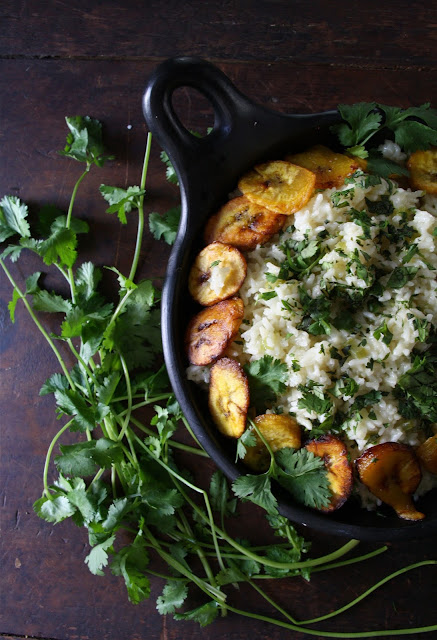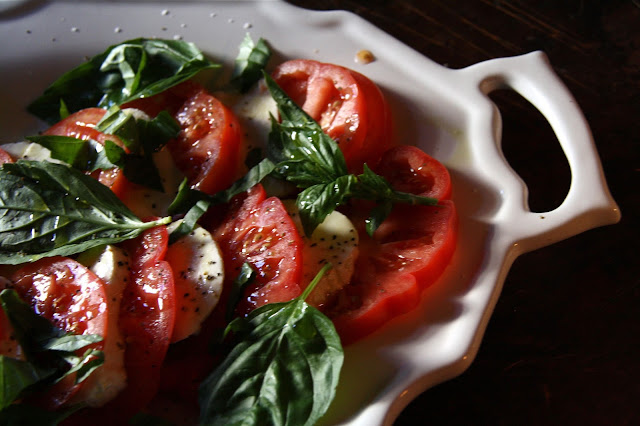In addition to cooking plantains for the first time, my eyes and palate were opened to the flavor (and heat) of Serrano chiles. Apparently my culinary life has been a little more sheltered than I have been willing to admit. This Mexican White Rice with Fried Plantains was the perfect way to expand my gastronomic horizons.
In addition to being insanely delicious, it is a relatively inexpensive dish to make. A little olive oil, celery, half of an onion (sweet yellow or white), garlic, half of a Serrano chili, a small bunch of cilantro, some long (or extra-long) grain rice, some kosher salt, chicken broth, two black (ripe) plantains and some vegetable oil make up the ingredients.
I used a sweet yellow onion instead of the white onion we used in class. Feel free to use either one, although the white onion is the onion of choice in classic Mexican cooking. Both the onion and celery should be cut to fine dice. While the garlic and Serrano chile are finely minced. The heat in this rice dish comes from a half of Serrano chile, seeds and all. As someone who doesn't really do 'hot' well, this rice dish had just the right amount of heat.
After the diced onions and celery are sautéed until the onions are slightly translucent, the garlic and chile are added and cooked for 30-45 seconds before the rice is added. Long grain rice is the rice most commonly used in Mexican cooking. Chefs like Rick Bayless and Zarela Martinez recommend using a medium-grained white rice for best results as the long grain rice found in the US is not comparable to the long grain rice found in Mexico. Having learned that after I made this rice dish and using extra-long instead of long grain rice, all I will say is that my choice of rice did not at all affect the incredible flavor of this dish. What it did affect was my rice cooking time.
Before the chicken stock is added to the saucepan, the rice is cooked along with the sautéed vegetables until it is slightly translucent (approximately 3-4 minutes). During this phase of cooking, you will be stirring the rice constantly. However, once you add the chicken stock and reduce the temperature to low, the covered pot remains undisturbed for at least 15 minutes or until all of the liquid has been absorbed by the rice. Side note: My cooking time was almost 25 minutes.
According to Wikipedia 'Plantains contain more starch and less sugar than dessert bananas and are therefore usually cooked or otherwise processed before being eaten'. Sometimes referred to as the pasta and potatoes of the Caribbean, they have found their way into the produce section of many grocery stores. As the peel changes to black, the plantain becomes sweeter while still retaining the firmness necessary for frying.
The skin of a plantain is much thicker than that of a banana and requires a few knife cuts to remove it. By making several long cuts though the skin from one end of the plantain to the other, the skin removes easily. When frying the plantains in vegetable oil, keep these two things in mind: (1) make sure your vegetable oil is hot and (2) work in batches so you don't overcrowd the plantains. The cooking time for 1/4" slices is approximately 1-2 minutes. Transfer the cooked plantains to a dish lined with paper towels and season with kosher salt. Side note: You can make the plantains either before or while you are making the rice. They don't necessarily need to be hot when added to the rice.
The cooked rice is finished with chopped cilantro and the fried plantains served either in a bowl or platter. If you are not a big fan of cilantro, this Mexican White Rice with Fried Plantains might have you changing your mind.
In addition to being a perfect side dish to tacos, this Mexican White Rice with Fried Plantains would compliment a grilled chicken dish or any other Mexican entree. Although I could just eat this rice as a meal. Especially if margaritas were involved! Or maybe to pay homage to the Olympics in Brazil, I should serve this dish with some Caipirinhas (Brazil's national cocktail) using some of the Cachaca (clear sugarcane hard liquor) the person who shall remain nameless brought back from a work trip to Brazil last week. Served with or without alcohol or with or without tacos this Mexican White Rice with Fried Plantains could end up being one of your favorite side dishes. Or if you are anything like sheltered me, open your palate to the deliciousness of fried plantains.
Mexican White Rice with Fried Plantains (ever so subtle changes to Robin Nathan's Mexican White Rice with Sweet Plantains recipe)
Ingredients
Rice
2 Tablespoons olive oil
1/2 large sweet yellow or white onion, finely diced
2 stalks celery, finely diced
4 cloves garlic, minced
1/2 Serrano chile (with seeds), finely minced
2 cups long grain or extra long grain white rice
4 cups chicken broth
Kosher salt to taste
1/4 cup chopped fresh cilantro
Plantains
2 ripe (black) plantains, peeled and cut into 1/4" slices
Vegetable oil for frying
Kosher salt
Directions
Rice
1. Heat oil in a heavy medium sized pan or stock pot.
2. Add onion and celery, sautéing until onion is slightly translucent (approximately 2-3 minutes).
3. Add garlic and chiles, continue to cook for an additional 30-40 seconds, stirring constantly.
4. Add the rice and stir to coat with vegetables. Cook until rice becomes slightly opaque (approximately 3-4 minutes).
5. Add broth and a generous pinch of salt. Bring to a quick simmer, cover, reduce heat to low and cook undisturbed for 15-25 minutes (or until all of the liquid has been absorbed by the rice). Note: My cooking time for the rice was almost 25 minutes. This may have been due to the level of heat or size of pot. Would recommend checking for doneness at 15 minutes and then continue cooking until rice is done.
6. Fluff with a fork and transfer to serving bowl or platter.
7. Sprinkle with chopped cilantro
Plantains
1. In a large, preferable non-stick skillet, pour in vegetable oil to coat bottom of pan and to a height of approximately 1/4".
2. When oil is hot, add a third or half of the plantain slices (you do not want to overcrowd the pan). Cook for 1-2 minutes per side, flip when lightly browned. Repeat with remaining plantains.
3. Place cooked plantain slices on a plate lined with a paper towel. Season with kosher salt.
4. Arrange plantain slices around the edge of the bowl/platter of Mexican White Rice.
5. Serve immediately.
Images from a walking tour of Philadelphia (Summer 2015).



























































